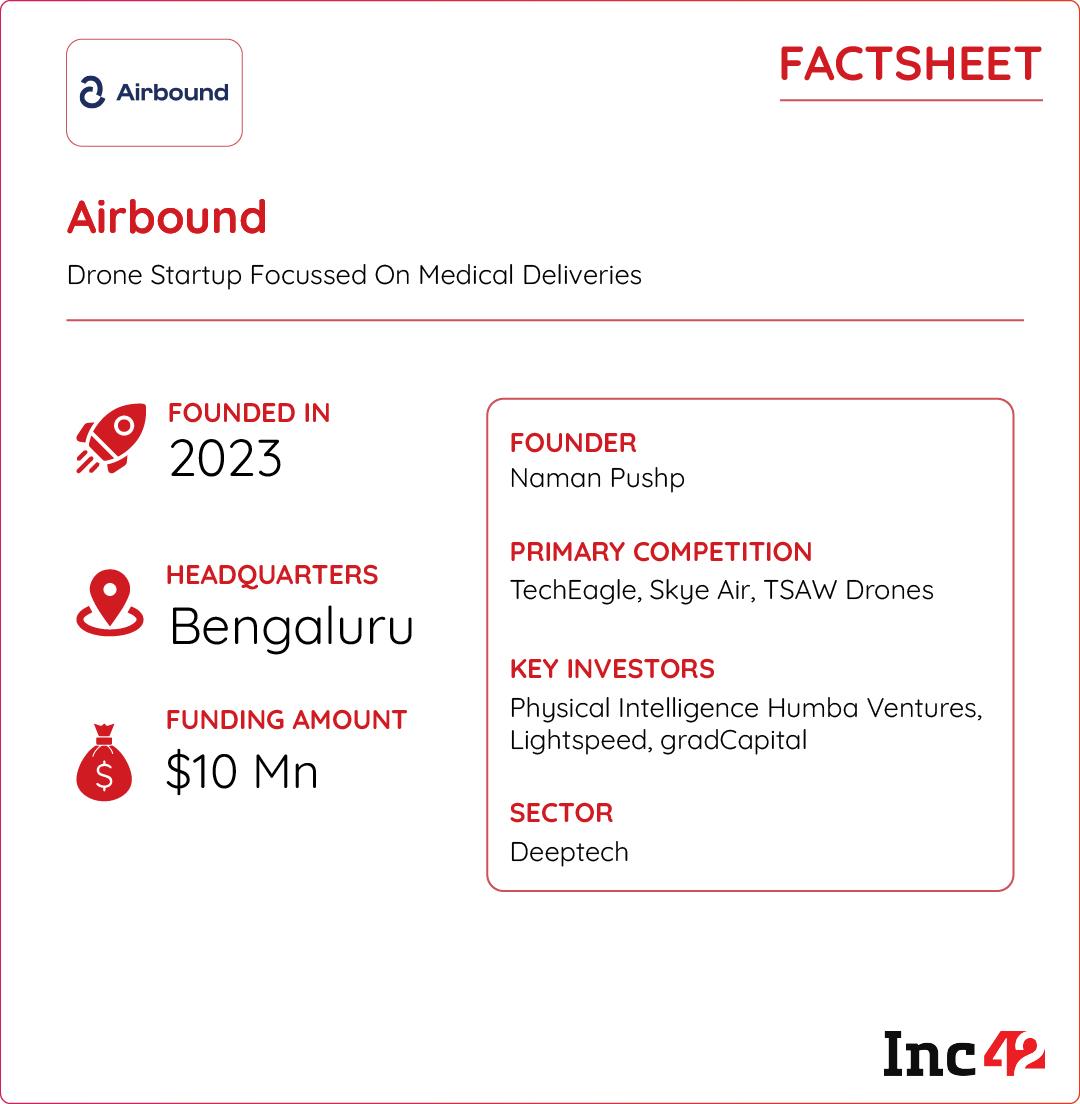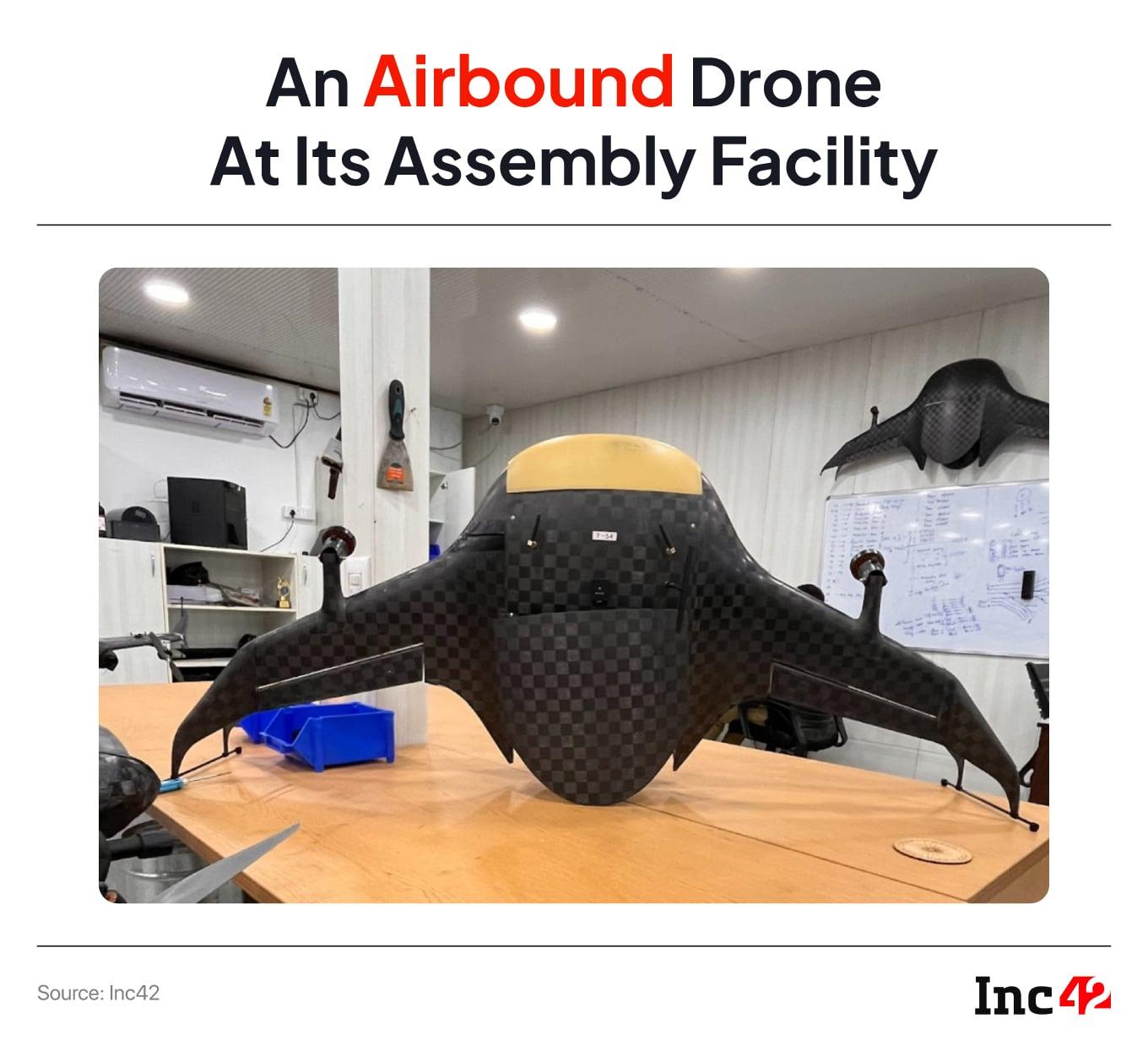Epic tells us the story of medicinal herbs being flown to save a dying soul. Bengaluru-based Airbound vows to do the same job for ailing patients today. What changed in the 7,000 to 14,000 years in between is precision. The saviour in the Ramayana couldn’t spot the right plant and brought the entire mountain, instead, from the Himalayas to Lanka deep down south.
But the startup is set to send the right medicine to the right patient right away, thanks to lower payload and higher degree of precision automation.
The concept of airborne healthcare supplies was tested on the quiet outskirts of Hoskote in Bengaluru recently, when five drones took to the skies with a sharp 90-degree take-off, zipped through the mid-day breeze with birds, and landed in effortless accuracy at the target spot.
It was more than a demonstration. It was a promise – a glimpse of how medical deliveries by drone could soon take shape in India’s revolutionary digital landscape.
Behind the airshow was Airbound, a young drone startup preparing to deliver blood samples, test reports, and other critical medical supplies to and from the city’s one of the top cardiac care facilities, Narayana Hospital.
“The mission is simple,” founder and chief executive Naman Pushp told Inc42. “We want to make healthcare logistics faster, more reliable, and independent of Bengaluru’s gridlocked roads. Or, for that matter, independent of the roadway transport constraints in any cities, towns, or villages.”
Airbound, however, is not the first to propose healthcare supply through drones. Earlier this year, TechEagle partnered with Apollo Hospitals to introduce 10-minute diagnostic drone delivery. Skye Air, which enables quick commerce deliveries in Bengaluru, proposed medical deliveries as a business proposition. Even TSAW Drones made some progress in its medical delivery services.
In light of the competition, Airbound claims its flagship TRT drones are distinct in nature. The vertical take-off and landing (VTOL) drones work with quadcopters and have a blended wing body that was never flown in India, according to the 20-year-old founder.
Pushp believes that with the drone’s unique design (see below) and the choice of material and components, Airbound can reshape drone-based healthcare logistics in India.

The dream that Pushp cradled was nurtured by the backing of senior leaders at Tesla, Anduril, and Physical Intelligence, as well as VCs like Lightspeed and Humba Ventures. But the story behind the making of the startup is of three years of hard toil and sustained focus in collecting a bunch of scattered ideas to give shape to Airbound in 2023.
A Student & Some Marquee Names“I was 15, attending online classes when the Covid-19 pandemic struck. I came across communities of engineers working on various projects to help others in those trying times,” recollected Pushp.
Many of those projects never saw the light of the day, but Pushp was undeterred. Although he was not initially focussed on medical deliveries by drones, the idea shaped up gradually. A year later, he created a virtual model of this drone. This design impressed gradCapital and the VC, which is known for backing startups launched by college students, cut its first $25,000 cheque for Pushp.
Soon after graduating in 2022, Pushp went for a pre-seed round, backed by Lightspeed. And, Airbound came up as a company next year.
If the pandemic prepared the field for Pushp’s idea to germinate, then inspiration from American tech firm Zipline helped it proliferate. Functioning since 2016, Zipline is today known for delivering life-saving drugs in remote parts of Africa.
“When I am in a place where there are no medical supplies, I will not think about biscuits. This gave me clarity on what I should do. If I am doing 100 deliveries a day, the most value I can add is by doing healthcare deliveries and connecting people to healthcare supplies,” said the founder.
Airbound is capable of manufacturing one drone a day, raising the scale from two a month. Pushp claimed that the feat makes it the largest drone maker in the country. The company plans to use $8.6 Mn it raised in a recent seed funding round to scale drone manufacturing and improve reliability of its vehicles.
The claims, however, raise many doubts and so does the extraordinary growth trajectory of the company in a sector that even today depends heavily on imported components or CKD (completely knocked down) parts. Then what drove some of the marquee names to back a student founder even before his brainchild went into commercialisation? Inc42 took a deep dive to decode the technology.
Inside Tech, Materials & ComponentsAirbound ventured into the drone space through the niche design area of blended wing body (BWB) aircraft, where only a handful of global players like Nautilus, JetZero, and Northrop Grumman, are developing commercial and fighter aircraft.
These carriers are known for their unconventional design, where the wing and fuselage or the main body are blended to form the aircraft. This makes BWB aircraft aerodynamically more efficient and reduces power consumption, while making them more environment-friendly.
The Airbound founder explained that most aircraft in use today have a fuselage in the middle of two jutted-out wings. The wings generate the lift, but the fuselage adds to the dead weight. “This dead space is needed to carry people or cargo. But the idea of BWB is to merge the fuselage and the wings, ensuring that the fuselage enhances the lift.”
Pushp refers to it as an aircraft that doesn’t need a runway. “The other VTOL designs that you see are like an aeroplane, with a bunch of propellers on top, which increases weight, drag, and interferes with the lift. We realised that this idea of something that takes off vertically, then rotates, and flies forward, is more efficient. We call our product a zero-compromise VTOL.”
Airbound has come up with another novel idea of using carbon fibre, which is extremely lightweight, to replace steel or any other heavier material. Quadcopters, or the four-rotor Indian drones, need 100 KgF thrust to lift a 100 Kg payload. The current VTOL quadcopters, Pushp said, need 30-50 KgF thrust to lift a similar payload. That’s the kind of ratio they follow.
Airbound TRT, on the other hand, needs only 5-8 KgF of thrust to lift a 100 Kg payload. Its 2.5 Kg Airbound TRT drone can lift a 1 Kg payload. As the startup scales and manufacturing becomes more efficient, it looks to achieve a milestone where a 1.2 Kg aircraft will be able to lift a 3 Kg payload.

That explains how Airbound’s technology can reduce energy consumption and increase delivery efficiency. It now costs around INR 24 for each delivery. The company aims to bring it below INR 5 as it scales manufacturing in the next one year. Ultimately, it aims to reduce it to INR 1 per delivery.
While the founder did not divulge the exact cost of making a drone, he said that it would be down to INR 30,000 to INR 50,000 in the next few years, as the company plans to make at least a few hundred drones a day.
The plans may sound probabilistic, given the countless external variables at play, investors chose to bet on the brain more than the brainchild. That’s what reflected from Airbound’s early investors like gradCapital and Lightspeed.
“When I met Naman, he was a 16-year-old boy showing me models of this drone on a computer and describing how it would fly. There was no real drone, yet he was writing equations about it. At that point, the engineering intuition I saw in him was at the level of an MIT PhD. To me, it was clear he was a prodigy,” Abhishek Sethi, partner and CEO of gradCapital, told Inc42.
Sethi said that Pushp’s initial hypothesis of building a VTOL to save money on the runway and one that would be much better than a quadcopter didn’t change. “Even his design idea for the aircraft hasn’t changed. When we invested, the idea to use carbon fibre wasn’t there, but we had the conviction that he would end up discovering a material to make the best aircraft.”
Airbound has achieved autonomy to a large extent in terms of technology. Its aircraft control tech stack RUDRA allows a single pilot to operate more than 100 aircraft if their paths are checked, and take-offs and landings are given as commands.
At a 40 Km range and 60 Kmph speed, which its TRT drones are capable of, Airbound can complete three to five deliveries on a single charge within 30 minutes.
Its design and the use of carbon fibre are proprietary. Though the startup imports some of the components, like the motors and propellers, Airbound plans to start manufacturing its own propellers in-house in the near future.
Airbound has so far filed for one patent on the BWB aircraft design in the US.
Fit To Fly Even In Rough Weather?Regulatory hurdles have been the biggest bottleneck for businesses in India. Airbound’s TRT drones need a type certificate issued by aviation regulator DGCA for its commercial operations. The biggest challenge for the company is that its timeline for getting the certification is yet unclear.
“With type certification, a design gets locked. We are in a process of continuous improvement, and we cannot pass on those to our customers if you lock everything behind a type certificate,” complained the founder. The company is trying to get as many improvements as possible in its first iteration before moving for the type certification.
As Airbound aims at a trillion deliveries a day – a distant dream, beyond doubt – it first needs to clear the regulatory hurdles. In fact, it is yet to receive a UIN from the regulator.
The pilots with Narayana Hospital are set to take off. The hospital’s founder and chairman, Dr Devi Shetty, has confirmed that this pilot with Airbound will help the institution improve the speed and reliability of its medical deliveries.
Airbound is also in talks with a few quick commerce platforms for pilots, but Pushp said that nothing has materialised so far. Why not groceries after medicines? The founder weighs it too.
The startup is also in talks with some American businesses as it looks beyond India. While Pushp refrained from sharing a concrete timeline for global expansion, he hinted that the company would only do so once its domestic operations are firmly established. Still, there’s visible excitement among insiders about tapping global markets, especially those with more mature drone regulations than India.
Hurdles and challenges aren’t new in the skies, tells the epic. Even bringing the life-saving herbs had met with multiple obstacles. But, the life was saved at last. For Airbound, the hurdles are evenly balanced by strong backing from marquee investors, robust demand from India’s last-mile healthcare grappling with rickety infrastructure in villages and increasing traffic snarl in cities, and a rapidly maturing drone ecosystem in India.
[Edited by Kumar Chatterjee]
The post Can This Bengaluru Startup Realise The Drone Delivery Dream For Medical Emergencies? appeared first on Inc42 Media.
You may also like

Harshvardhan Rane recalls his salary of 'Rs 10 a day, plate of choley chawal'

RBI boosts gold holdings in India to 575.8 tonnes; domestic prices edge higher

How Indian LPs Should Approach Early Stage VC Now

Cyclone Montha impacts Bihar, IMD issues heavy rainfall alert for several districts

IND vs AUS: Jasprit Bumrah Is Suryakumar Yadav's Primary Weapon Against Australia in T20Is






